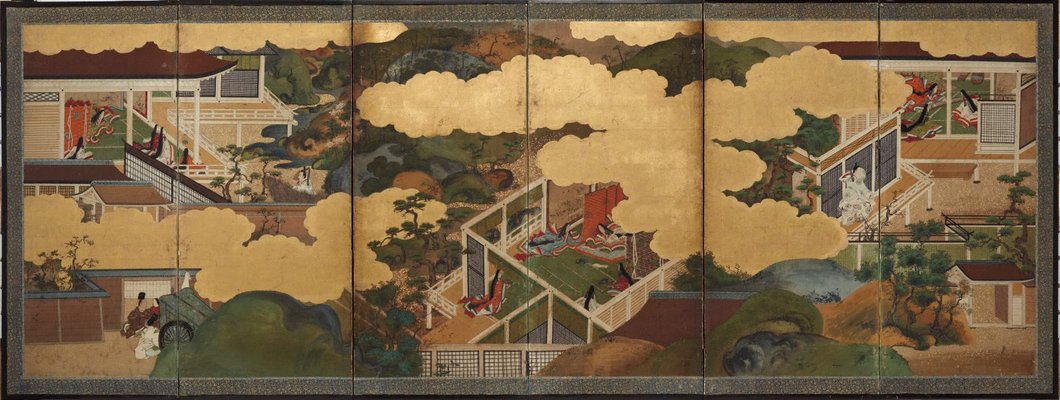

-
Details
- Place where the work was made
-
Japan
- Date
- 1700-1750
- Media categories
- Screen , Painting
- Materials used
- pair of six-panel screens (byobu); ink, colour, gold and 'gofun' on paper
- Dimensions
-
a - right screen - boating party at lower left, 109 x 289 cm
b - left screen - cart in lower left corner, 109 x 289 cm
- Credit
- Gift of Lesley Kehoe 2009. Donated through the Australian Government Cultural Gifts Program.
- Location
- Not on display
- Accession number
- 182.2009.a-b
- Copyright
- Artist information
-
Tosa School
Works in the collection
- Share
-
-
About
The scenes in these screens are read from right to left and begin with an episode from Chapter 6 in the 'Tale of Genji', when Prince Genji steals into the mansion of Princess Suetsumuhana and listens to her playing the Japanese zither called koto. The central vignette represents Chapter 21. It shows the page girl sent by Empress Akikonomu carrying a box of autumn leaves and poem for Murasaki, Genji's main consort. The final scene depicts Genji peering over a brush fence at the young Murasaki, a common motif to illustrate Chapter 5.
The first scene in the left screen represents Chapter 23 and shows Genji paying his New Year’s visit to the Akashi lady in her elegantly appointed quarters. The vignette at the centre refers to Chapter 3. It portrays two young women playing the board game of go, unaware that they are being watched by Genji. The last two panels on the right border show Genji's son Kaoru courting the ladies of Uji; this refers to developments in Chapter 46.
Asian Art Department, AGNSW, September 2011
-
Places
Where the work was made
Japan
-
Exhibition history
Shown in 2 exhibitions
Genji - the world of the Shining Prince, Art Gallery of New South Wales, Sydney, 12 Dec 2008–15 Feb 2009
Conversations through the Asian collections, Art Gallery of New South Wales, Sydney, 25 Oct 2014–13 Mar 2016
-
Bibliography
Referenced in 2 publications
-
Khanh Trinh (Editor), Genji - the world of the Shining Prince, Sydney, 2008, 14-15 (colour illus.). fig. 5
-
Jane Wynter (Editor), Foundation Newsletter #14, Sydney, Jun 2009, (colour illus.). The colour illustration is of the right screen.
-


